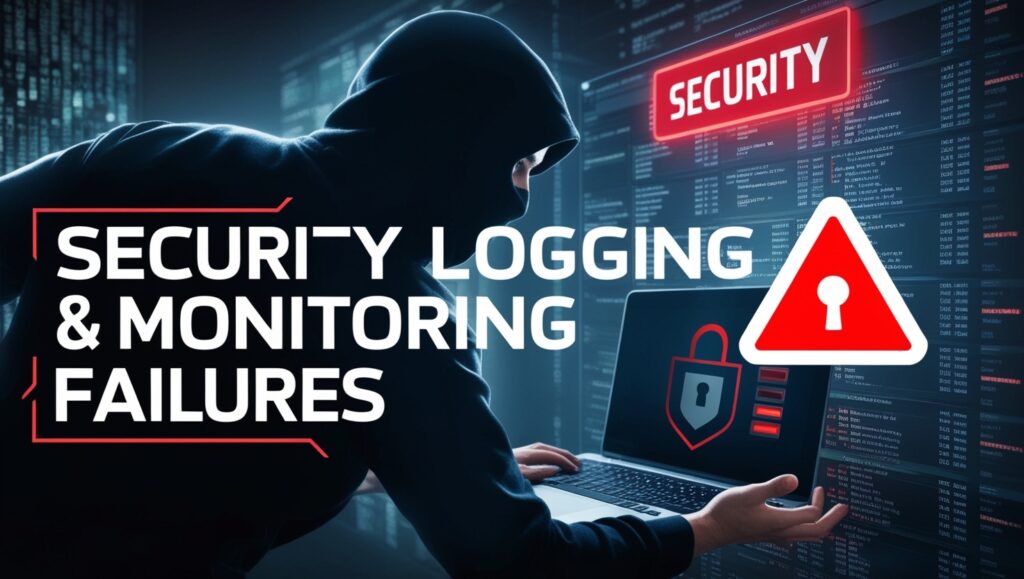1. Introduction to Security Logging and Monitoring Failures
Security logging and monitoring failures are among the most critical weaknesses in cybersecurity. Without proper logging and monitoring, organizations remain unaware of security breaches until it’s too late. According to the OWASP Top 10, these failures can lead to delayed breach detection, data loss, and compliance violations. Ensuring robust security logging and real-time monitoring is essential to mitigate cyber threats effectively.

2. Why is Security Logging and Monitoring Important?
Security logging and monitoring play a vital role in detecting, analyzing, and responding to cyber threats. Here are three reasons why they are crucial:
- Early Threat Detection: Proper logging allows organizations to detect security incidents before they escalate into major breaches.
- Forensic Investigation: Logs provide essential data for analyzing cyber attacks and understanding how they occurred.
- Regulatory Compliance: Many laws, including GDPR, PCI-DSS, and HIPAA, require organizations to maintain security logs for audit purposes.
3. Common Security Logging and Monitoring Failures
Many organizations suffer from poor security logging practices. Here are five common failures:
- Lack of Centralized Logging: Storing logs in different locations makes it difficult to track and analyze security events.
- Failure to Monitor Logs: Many organizations collect logs but do not actively monitor them, missing potential security threats.
- Storing Logs Insecurely: Unprotected logs can be altered or deleted by attackers to hide their traces.
- Too Many or Too Few Logs: Excessive logging can create noise, making it difficult to identify threats, while insufficient logging results in missing critical security incidents.
- Delayed Response to Alerts: Failing to act on security alerts quickly allows attackers more time to exploit vulnerabilities.
4. Real-World Examples of Logging and Monitoring Failures
Here are two real-world examples that highlight the importance of proper security logging and monitoring:
- Equifax Data Breach (2017): Equifax failed to detect a web application vulnerability that exposed the personal data of 147 million users. Poor logging and monitoring contributed to the delay in discovering the breach.
- Target Breach (2013): Target’s security system detected malicious activity, but due to inadequate monitoring and delayed response, hackers stole 40 million credit card details.
5. How Attackers Exploit Poor Logging and Monitoring
Cybercriminals take advantage of security logging and monitoring failures in the following ways:
- Log Tampering: Attackers erase or alter logs to cover their tracks and avoid detection.
- Slow Detection Times: Without real-time monitoring, security teams may take days or weeks to detect an attack.
- Privilege Escalation: Hackers use undetected vulnerabilities to gain higher system privileges and execute malicious activities.
- Data Exfiltration: Insufficient logging allows attackers to steal sensitive data without raising alarms.
- Brute Force and Credential Stuffing Attacks: Weak monitoring systems fail to identify repeated unauthorized login attempts.
6. Best Practices for Security Logging and Monitoring
To prevent security logging and monitoring failures, organizations should follow these best practices:
- Implement Centralized Logging: Use Security Information and Event Management (SIEM) solutions for centralized log collection and analysis.
- Enable Real-Time Monitoring: Set up alerts for unusual login attempts, data access, or suspicious activities.
- Use Log Retention Policies: Maintain logs for a sufficient period to assist in forensic investigations.
- Encrypt and Secure Logs: Protect log files from unauthorized access, modification, or deletion.
- Regular Log Auditing: Conduct periodic reviews to identify anomalies and potential security gaps.
7. Essential Tools for Security Logging and Monitoring
Several tools help organizations strengthen their security logging and monitoring processes. Here are the top five:
- Splunk: A powerful SIEM tool for real-time data monitoring and analysis.
- ELK Stack (Elasticsearch, Logstash, Kibana): Open-source logging and visualization solution.
- Graylog: A centralized log management tool for security monitoring.
- OSSEC: A free intrusion detection system for monitoring system logs.
- Wazuh: An open-source security platform for threat detection and compliance.
8. Compliance and Regulations Related to Logging
Many regulatory bodies require businesses to maintain proper security logs. Here are three major compliance frameworks:
- GDPR (General Data Protection Regulation): Requires organizations to log access and modifications to personal data.
- PCI-DSS (Payment Card Industry Data Security Standard): Mandates logging of payment transactions and monitoring for fraudulent activities.
- HIPAA (Health Insurance Portability and Accountability Act): Ensures that healthcare organizations log and monitor electronic health records.
9. Conclusion: Strengthening Security Through Better Monitoring
Security logging and monitoring failures can expose organizations to severe cyber threats. Implementing best practices, using robust security tools, and ensuring compliance with regulations help prevent attacks. Organizations must adopt proactive monitoring strategies to detect, analyze, and respond to threats before they cause damage.
10. FAQ: Common Questions About Security Logging and Monitoring Failures
Q1: What is the biggest risk of security logging failures?
A: The biggest risk is delayed breach detection, which allows attackers to exploit vulnerabilities undetected.
Q2: How can businesses improve their security monitoring?
A: Businesses should use SIEM tools, enable real-time alerts, and regularly audit logs for anomalies.
Q3: Which industries require strict logging and monitoring compliance?
A: Finance, healthcare, and e-commerce industries have stringent regulatory requirements for logging and monitoring security events.

Leave a Reply